![]()
![]()
![]()
Use LEFT and RIGHT arrow keys to navigate between flashcards;
Use UP and DOWN arrow keys to flip the card;
H to show hint;
A reads text to speech;
188 Cards in this Set
- Front
- Back
|
What are the 4 major areas of biological psychology |
1) genetic and evolutionary perspectives on behaviour 2)how the nervous system works: cells and neurotransmitters 3)structure and organization of the nervous system 4) Windows to the brain: measuring and observing brain activity |
|
|
What are the 2 perspectives in genetic and evolutionary perspectives on behaviour |
Nativist- emphasized genes and inborn characteristics (nature) Empiricist- focused on learning and experience (nurture) |
|
|
What is evolutionary psychology |
Field that emphasizes evolutionary mechanisms that explain human commonalities in cognition, emotion, development and behaviour |
|
|
What is behavioral genetics |
Interdisciplinary field of study that deals with the genetic bases of individual differences in behaviour and personality |
|
|
What are genes |
Basic units of heredity Made of DNA and specify the structure of proteins |
|
|
What are chromosomes |
Rod shaped structures in the nucleus Carry genes |
|
|
What is genotype |
Genetic makeup of organism Set of genes that comprise an individual's genetic code |
|
|
What is phenotype |
Physical traits and behaviourso characteristics that show genetic variation |
|
|
What are homozygous genes |
When 2 corresponding genes at a location on a pair of chromosomes are the same (TT or tt) |
|
|
What is heterozygous genes |
When 2 corresponding genes at a location on a pair of chromosomes are different (Tt) |
|
|
What is DNA |
Deoxyribonucleic acid -chromosomal molecule that transfers genetic characteristics by coded instructions for the structure of proteins |
|
|
What are the chemical elements in DNA |
Adenine (A) Thymine (T) Cytosine (C) Guanime (G) |
|
|
What is human genome |
Full set of genes in each cell of an organism -one gene isn't responsible for a broad -inheritance doesn't mean you show the triat |
|
|
What are linkage studies |
Studies that look at patterns of inheritance of tent if markers in families where a particular condition is common |
|
|
What is a genetic marker |
Segment of DNA that varies among people Has known location on chromosome Genetic landmark for a gene |
|
|
Polygenic genes |
Human traits influenced by more then one gene pair (polygenic) |
|
|
What is evolution |
Change in gene frequencies within a population over generation Mechanisms that influence my change Can make changes in species and lead to new species |
|
|
2 ways gene frequencies change |
Mutations Natural selection |
|
|
What are mutations |
Changes in genes caused by an error in the copying of the original DNA sequence during cell division that makes sperm and eggs |
|
|
What is natural selection |
Formulated by Darwin Individuals that have traits that are adaptive to an environment tend to survive and reproduce in greater numbers then others (Servival of the fittest) |
|
|
What us heritability |
Statistical estimate of the proportion of the total variance in some trait that is attributable to genetic differences in individuals in a group. Max value of 1.0 Higher=greater genetic contribution to trait |
|
|
Factors of heritability |
1) estimates apply to a group in a particular environment 2) estimates apply to variations of group not individuals 3) high heritable traits can be modified by environment |
|
|
How can we study heritability |
-By studying people whose genetic similarity is known - can separate the role of genetics and environment by studying adopted children |
|
|
What's one approach to computing heritability |
Comparing identical (monozygotic) and fraternal (dizygotic) twins Can study twins separated early in life that are raised apart |
|
|
What happens to heritability with higher identical twins |
If Identical twins are more simular than fraternal twins then there is greater gentic influence |
|
|
Twins |
Identical (monozygotic) Fraternal (Dizygotic) like siblings Assumed to share similar environments |
|
|
Twin studies |
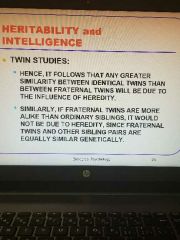
|
|
|
What is iQ |
Intelligence quotient -measure of intelligence (Old way) dividing a person mental age by their chronological age and multiplying by 100 (New way) created from norms provided for standardized intelligence tests |
|
|
IQ in siblings |
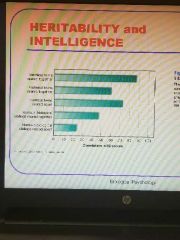
|
|
|
Heredity and environment always interact to produce the unique mixture of qualities that make a human |
Know |
|
|
Reaction ranges |
Genetic component sets certain limits, for people there is a rage of possible responses to the environment someone encounters -intellectual development has a reaction range |
|
|
3 environmental influences associated with high intellectual ability |
- good health care and nutrition -environmental stimilatation in home, child care, school -parental interaction, discussion and encouragement of mental processing |
|
|
Environmental influences associated with low intellectual ability |
-Poor parental care -malnutrition -exposure to toxins -stressful family circumstances |
|
|
What is sociobiology |
Interdisciplinary field that emphasizes evolutionary explanations of social behaviour |
|
|
Why do we tend to act in certain ways |
Tendency to act in ways to maximize chances of passing on out genes as well as helping close biological relatives do the same |
|
|
What is intrasexual selection |
Members of the same sex compete for a partner of the other sex (males become more muscular) |
|
|
Sexual strategies differences |
Differences in servival and mating problems have led to differences in aggression, dominance and sexual strategies in male and females |
|
|
Example in males Example for female |
-Males computer with other males to access as many females as possible -larger biological investment so they prefer men who enhance mating success (fit) |
|
|
Preferences in mates |
Men prefer to marry younger women Women prefer older men (Age predicts status and dominance in men) (Age predicts fertility in women) |
|
|
What is neuropsychology |
The study of the relationship between the nervous system and behaviour |
|
|
What are the 3 main types of specialized cells |
Receptor cells Motor cells (effectors) Neurons |
|
|
What are receptor cells |
Receive sensory information from the environment |
|
|
What are motor cells |
Control muscle movement and the secretion of glands |
|
|
What are neurons |
Conduct singles from 1 cell at part to another Relate and coordinate info between receptor and motor cells |
|
|
What are the basic units of the nervous system |
Neurons Glia |
|
|
What do glia do |
-structural support to neurons -nutrients to neurons -barrier to bloodstream -insulate neurons -remove debris when neuron dies -enhance formation and maintenance of neural connections -modify neural functioning |
|
|
What are the 3 types of neurons |
Sensory- carry informations to spinal cord and brain Motor- send messages to muscles Internurons- link sensory and motor neurons |
|
|
What is the structure of the neuron |
Cell body -nucleus Dendrites Axon -axon terminals -nerves |
|
|
What is the myelin sheath |
fatty material surrounding the axons -to speed the conduction of neural impulses and prevent interference from neighbouring signals -divided into segments from constructions in covering |
|
|
Electrochemical transmission Electrical part |
Ions -electrically charged molecules or atoms Resting potential Action potential |
|
|
What is resting and action potential |
Resting - inside of a cell is negatively changed while outside is positively charges Action - inside of a cell is positively charged and outside is negatively changed |
|
|
Electrochemical transmission Chemical part (how do neurons communicate) |
-messaged are transmitted through transmitter substances to another neuron -action potential reaches end of axon and transmitter substances are released into synapse -chemical fills synapse between axon and next neuron transmitting message -messaged is then revived by dendrites |
|
|
What is the synapse made of |
Axon terminal Synaptic cleft Receptor sites in the membrane of receiving cell |
|
|
What are neurotransmitters |
Chemical substance that is released by transmitting neuron at synapse and alters the activity of receiving neuron |
|
|
Whay are the major neurotransmitters |
Serotonin Dopamine Acetylcholine Norepinephrine GABA Glutamate |
|
|
What are the 2 ways a message can be transmitted |
Excitatory -causing a reaction in the receiving neuron Inhibitory -decreasing or preventing a response in the receiving neuron |
|
|
What is the function of glutamate |
Excites nervous system; memory and autonomic nervous system reactions |
|
|
What is the function of GABA (Gamma-amino butyric acid) |
Inhibits brain activity, lowers arousal, anxiety, and excitation Facilitates sleep |
|
|
What is the function of acetylcholine |
Movement Attention |
|
|
What is the function of dopamine |
Control of Movement, reward seeking behaviour Cognition and attention |
|
|
What is the function of norepinephrine |
Memory, attention to new or important stimuli Regulation of sleep and mood |
|
|
What is the function of serotonin |
Regulation of sleep, appetite and mood |
|
|
Process of communication between neurons |
-nerve is stimulated making a electrical potential between inside and outside of cell -enough stimulation it makes action potential the sends an impulse down axon - axon terminals release neurotransmitters from synaptic vesicles into synaptic cleft - neurotransmitters bind to post synaptic receptor sites that they fit -causing excitatory or inhibitory inputs |
|
|
What are agonists |
Drugs that enhance or mimic the effects of a neurotransmitters action |
|
|
What are antagonists |
Drugs that inhibit neurotransmitter activity by blocking receptors or preventing synthesis of a neurotransmitter |
|
|
What are hormones |
Chemical substances made by organs called endocrine glad that affect the functioninhbof other organs |
|
|
What do hormones do |
Regulate growth, metabolism, sexual development and behaviour |
|
|
What are the 4 major hormones |
Melatonin Oxytocin Adrenal hormones Sex hormones ( androgens, estrogens) |
|
|
What are the 2 parts of the nervous system |
Central nervous system Peripheral nervous system |
|
|
What does the central nervous system do |
Revived, processes, interprets and stores incoming sensory info Sends out messages to muscles, glands, and internal organs |
|
|
What are the 2 main parts of central nervous system |
Brain spinal cord -bridge between brain and parts below neck -spinal nerves protected by spinal column -enables spinal reflexes |
|
|
What does the peripheral nervous system do |
Handles input and output from central nervous system |
|
|
What do sensory and motorvnerves do in the peripheral nervous system |
Sensory - carry messages from sensory receptors to spinal cord then to brain Motor- carry orders from central nervous system to mucles, glands, organs |
|
|
What are the 2 divisions of the peripheral nervous system |
Somatic nervous system -nerves connected to sensory receptors and skeletal muscles Autonomic nervous system -Regulate the functioning of blood, vessels, glands, internal organs |
|
|
What are the 2 parts of the autonomic nervous system |
Sympathic -energy expending system -operates in emergency situations Parasympathetic -energy conserving system -operates under normal, relaxed conditions |
|
|
What is localization of function |
Specialization of particular brain areas for particular functions |
|
|
What are the 4 major parts of the brain |
Hindbrain Midbrain Forebrain Cerebral cortex |
|
|
Parts of the hindbrain |
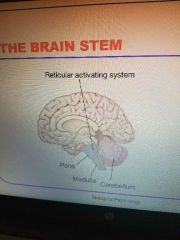
Brain stem -medulla -pons -reticular formation Cerebellum |
|
|
What does the medulla do |
Important in automatic functions |
|
|
What do the pons do |
Involve sleeping, walking, dreaming Transmits motor info from higher brain and spinal cord to cerebellum |
|
|
What does the reticular activating system do |
Arouses higher brain to incoming info Impotent for attention Screens incoming info |
|
|
What does the cerebellum do |
Regulate movement and balance Involved in learning simple skills and acquired reflexes Involved in cognitive tasks ( problem solving) |
|
|
What are the parts of the midbrain and y they important |
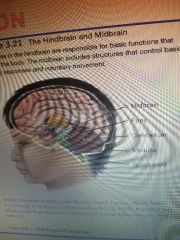
Superior colliculis Inferior colliculis |
|
|
What are the 3 parts of the forebrain |
Basal ganglia Thalamus Limbic system |
|
|
What are the 3 parts of limbic system |
Hypothalamus and pituitary gland Amygdala Hippocampus |
|
|
What are cerebral ventricles |

4 ventricles in brain with cerebrospinal fluid Provide nutrition and Cushioning for brain |
|
|
What do the basal ganglia do |
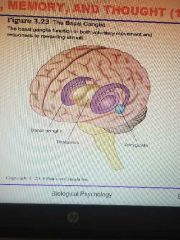
Function in both voluntary movement and response to swearing stimuli |
|
|
What is the thalamus |
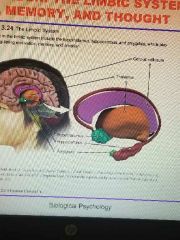
Structure that relates sensory messages to the cerebral cortex -all sensory messages but ones from olfactory bulb Integrates info coming from various areas of the cerebral hemispheres |
|
|
What does the hypothalamus do |
regulated autonomic nervous system(maintains homeostasis) Involved emotions, drives vital to survival like hunger and fear, reproduction |
|
|
What does the pituitary gland do |
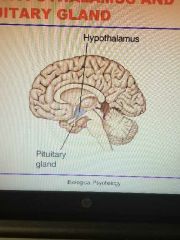
The largest gland Mast glad Endocrine glad at base of brain that releases hormones and regulates other glands |
|
|
What does the hippocampus do |
Involved in storage of new info in memory |
|
|
What does amygdala do |
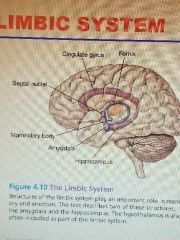
Involved in arousal and regulation of emotion Initial emotion response to sensory info |
|
|
What are the 4 parts of the cerebral cortex |
Occipital lobe Parietal lobe Temporal lobe Frontal lobe |
|
|
What is grey and white matter in the brain |
In the Cerebral cortex Consists of myelinated axon |
|
|
What is the cerebrum |
Largest part of brain Divided into hemispheres concerted by corpus callosum Has tightly packed layers of cells called cerebral cortex |
|
|
What does the patiental lobe do |
Includes somatosensory cortex (pain,pressure, touch, temp) Involved in attention and mental operations |
|
|
What is the frontal lobe made of |
Includes motor cortex and brocas area (left hemisphere) Involved in short term memory, emotion, planning, creative thinking |
|
|
What is the occipital lobe do |
Includes visual cortex |
|
|
What does the temporal lobe do |
Includes auditory cortex and wernike area (left hemisphere) Involved in memory, perception, emotion |
|

|
Know |
|
|
What is the case of phineas gage |
An explosion at railroad construction sent a rod through his head People said he was no longer himself Had problems with emotional processing and rational decision making |
|
|
Look at |
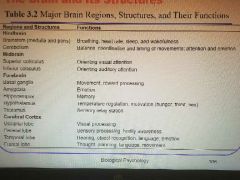
|
|
|
The two sides of the brain |
Left and right cerebral hemispheres Split by the corpus callosum Control opposite parts of the body If severed through split brain surgery, perception and memory are disturbed |
|
|
What has split brain studies demonstrated |
Most right handed and majority of left handed people process language in left hemisphere Left hemisphere dominance Righy hemisphere important for problem involving spatial visual ability, facial recognition, music processing, some language abilities |
|
|
What is neuroplasticity and examples |
Capacity of the brain to change and rewire itself based on individual experience Ex. Brain differences in musicians Brain damage Stroke recovery |
|
|
What is neuroethics |
Interdisciplinary specialty addressing the legal, ethical, and scientific implications of brain research |
|
|
What are the 4 kinds of mapping the brain |
Patients with brain damage Lesions method( damaging or removing part of brain) Electrical and magnetic detection Structural neuroimaging( brain scans) |
|
|
What are the 3 types of electrical and magnetic detection |
EEG MEG TMS |
|
|
What are EEGs |
Recoding neural activity detected by electrodes Limited precision as recording multiple cells Recent techniques include needle and micro electrodes |
|
|
What are MEGs |
Highly sensitive divces surround the skill to measure the magnetic fields created by electrical activity of nerve cells |
|
|
What are TSMs |
Use powerful magnetic field produced by wire coil placed on person's head to stimulate cells Cause need one to fire and inactivate others |
|
|
What are the 4 structural neuroimaging (brain scans) |
CT scans PET scans MRI scans DTI scans |
|
|
What is a PET scans |
Method to analyze biochemical activity in the brain using injections of glucose |
|
|
What are MRI |
Method for studying body and brain tissue using magnetic fields and special radio receivers Assessed by functional MRI or fMRI |
|
|
Second half |
New slide show |
|
|
What is consciousness |
Our awareness of ourselves and the environment |
|
|
What are biological rhythms |
A periodic, more or less regular fluctuation in a biological system Synchronized with external cues (enttianment) or internal cues (endogenous) |
|
|
Wjat are circadian rhythems |
Happen every 24 hours (sleep- wake cycle) Commonly entrained to external time cues Endogenous rhythms every 24.3 hrs Controlled by biological clock in suprachiasmatic nucleus |
|
|
What does suprachiasmatic nucleus (SCN) do |
Regulates levels of melatonin secreted by pineal gland |
|
|
What is internal desynchronization |
A state where biological rhythms are not in phase with another Caused by chances in routines Ex. Jet leg, rotating shut It work, daylight savings time |
|
|
What is seasonal affective disorder (sad) Moods and long term rhythms |
Where a person experiences depression during winter and improvement in spring Photithearapy or exposure to fluesent light as treatments |
|
|
Moods and menstrual cycles What is premenstrual syndrome (PMS) |
Cluster of physical and emotional symptoms associated with menstrations Physical (cramps, water retention) Emotional( irritability, deprrssion) rare |
|
|
Sleep |
Sleep is partially under voluntary control Microsleep Typical needs for disease needs and age |
|
|
What is Microsleep |
A momentary shift in brain activity to the pattern characteristics of sleep |
|
|
What are the 2 rhythms of sleep |
90 mins REM- eye movement, loss of muscle tone, dreaming NREM- fewer eye movements 4 stages |
|
|
What is the 4 stages of NREM sleep |
1) on edge of consciousness, light sleep, irregular alpha waves 2) presence is sleep spindles, noises won't wake u 3) delta waves start, breathing and pulse slow down 4) delta waves predominant, deep Sleep, sleepwalking can happen |
|
|
Waves in sleep |
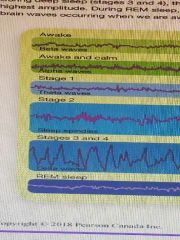
|
|
|
What are the theories of sleep |
Restore and repair hypothesis Reserve and protect hypothesis |
|
|
What is the restore and repair hypothesis |
Function of sleep unclear but allows for certain processes to happen like -Eliminating waste produce from mucles -Repairs cells -conserves and replenished energy stores -strengthens immune system -normal mental functioning -recovers abilities lost during day |
|
|
What is the preserve and protect hypothesis |
Preserve energy Protecting the individual organism from harm |
|
|
What are 3 consequences of sleeplessness |
Chronic sleep deprivation -increases cortical levels thay impair back cells involed in memory and leading Chronic insomnia -difficulty falling or stating asleep 10% adults have Daytime sleepiness Linked to inadequate sleep during night a s associated with decreased mental performance |
|
|
What is sleep apnea |
Disorder where breathing briefly stops during sleep causing person to choke and wake |
|
|
What us narcolepsy |
Disorder involving sudden dating attacks of sleepiness or lapses into REM sleep |
|
|
What is REM behaviour disorder |
Muscle paralysis associated with REM sleep does not occur and sleep may act out their dreams Mostly in men |
|
|
What are the types of insomnia |
Onset insomnia Maintenance insomnia Terminal insomnia Secondary insomnias |
|
|
What is nightmares and night terrors involve |
Nightmares -REM sleep -disturbing Night terrors -NREM -intense panic and arousal |
|
|
What are 3 movement disturbances |
Restless leg syndrome -5-10% of population -constant motion distubes sleep REM behaviour disorder Somnambulism -more common in children -safe to awaken |
|
|
What are the benefits of sleep |
Memory consolidation -synaptic changes associated with recently stored memories become durable making memory reliable Enhances problem solving abilities |
|
|
What are lucid dreams |
Dreams where the dreamer is aware they are dreaming. May be able to exert some control over dream |
|
|
What are the theories of the purpose of dreams |
Psychoanalytic Problem focused Cognitive Activation synthesis |
|
|
What is psychoanalytic approach |
Dreams our are unconscious wishes and desires |
|
|
What are manifest content and latent content |
Manifest -images and storylines we dream -parts that we consciously experience during sleep and may remwber Latent -actual symbolic meaning of a dream built on suppressed sexual or aggressive urges -parts that r unconscious wishes and thoughts being expressed symbolically |
|
|
What is problem focused approach |
Symbols and metaphors in a dream d9 not disguise it true meaning. It convey it Dreams contain related current concerns May provide opportunities to resolve problems |
|
|
What is cognitive approach |
View that dreams are a modification of the congnitve activity that happens when we are awake When sleeping we cut off sensory input and external feedback from the word and our bodily movements |
|
|
What is activationsynthesis theory |
Argued that dreaming comes from neurons firing suddenly in lower part of the brain, pons, during REM sleep Cortex tries to make sence of this by integrating it with existing knowlege and memories |
|
|
Look at |
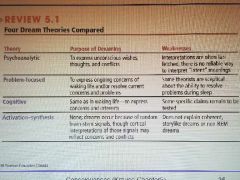
|
|
|
What us a hypnosis |
A procedure where the practitioner suggest changes in the sensations, perceptions, thoughts, feeling of a participant Methods use relaxation |
|
|
What is the nature of hypnosis (6 parts) |
1) hypnotic responsiveness depends more on the efforts and qualities of the paricapent then the skills of hypnotist |
|
|
Part 2 |
Hypnotized people can't be forced to do things against their will |
|
|
Part 3 |
Feats performed while under hypnosis can be performed by motivated people without hypnosis |
|
|
Part 4 |
Hypnosis dosent increase the accuracy of memory |
|
|
Part 5 |
Hypnosis doesn't produce a literal re experiencing of long ago events |
|
|
Part 6 |
Hypnotic suggestions have been used effectively for many medial and psychological problems |
|
|
What are the dissociation theorie of hypnosis (views) |
Hilgrad -dissociation or a split in consciousness in which one part of mind operates alone from the rest of consciousness (presence of hidden observer) Bowers et al - control of executive Function is weakened during hypnosis to an altered state of consciousness (not dissociated) |
|
|
Look at |
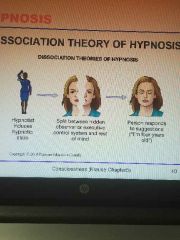
|
|
|
What is the social-cognitive theory of hypnosis |
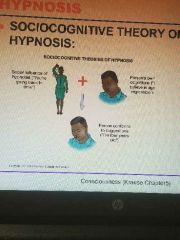
Effects of hypnosis results from an interaction between the social influence of hypnotist and abilities, beliefs, and expectations of subject |
|
|
What are the 2 networks involved in mind wandering |
Default mode network - self relates thinking Frontoparietal network -goal directed thought and planning |
|
|
What is a coma |
Consciousness disorder where Some reflexes, brain stem reflexes suppressed |
|
|
What is persistent vegetative state (PVS) |
Do not track movement Best home for covert before 6 months After coma |
|
|
What is minimally conscious state |
Behaviours beyond reflexes |
|
|
What us locked in syndrome |
Awake but unable to move |
|
|
What d9 we know about the assessment of consciousness in vegetative patients? |
Reflexes and simple responses Glasgow coma scale - assesses eye movements, response to pain, openness in response to speech, language, movement |
|
|
How can science explain consciousness in vegetative patients? |
Some patient in persistent vegetative state can show signs of consciousness fMRI techniques suggest comprehension of commands and mental imagery |
|
|
Can we critically evaluate thus evidence? |
Misdiagnosis of vegetative state Language ability not necessarily the same as consiousncess |
|
|
Why is this relevant? |
Life and death implications Life support decisions |
|
|
What is a psychoactive drug |
Substance that alters perception, mood, thinking, memory or behaviour by changing the body biochemistry |
|
|
What are the 6 classification of drugs |
Stimulants Depressants Opiates Hallucinogens Anabolic steroids Marijuana |
|
|
What are stimulants |
Drugs the speed in activity in the central nervous system Ex. Nicotine, caffeine, cocaine, amphetamines, methamphetamines |
|
|
What are depressants |
Drugs that slow down activity in the central nervous system Ex. Alcohol, inhalants, tranquilizers, barbiturates |
|
|
What are opiates |
Drugs from the opium poppy that relieve pain and commonly produce euphoria -heroin, morphine, fentanyl, ocycodonr Treatment challenging -methadone |
|
|
What are hallucinogens |
Drugs that produce hallucinations, change through processed or disrupt the norm perception of time and space Ex. Lsd, dmt, ketamine, masculine, salvia divinorum, psilocybin |
|
|
What are anabolic steroids |
Synthetic derivatives of testosterone that are taken by pill or injections To increase muscle mass |
|
|
What is marijuana |
Contains THC -binds cannabinoid receptors Related to mild euphoria, relaxation, intense sensations and various cognitive deficits Mimics neurotransmitter involved in sleep Reduces pain |
|
|
What do we know about the effects of marijuana on memory |
Disrupts short and long term memory Impairment of executive functions |
|
|
Haw can science explain these effects |
Changes in brain function Differing patterns of activity |
|
|
Can we critically evaluate this info |
fMRI is Correlatiomal Hard to isolate effects of marijuana |
|
|
What is this relevant |
Important for recovery from addiction |
|
|
What are psychoactive drugs |
They produce effects by acting on brain neurotransmitters (NT) -increase/decrease release of nts -prevent reabsorption or reuptake excess to nts -block effect of nts on receiving cells Bind to receptors in place of neurotransmitters |
|
|
What does cocaine do |
Blocks reabsorption of dopamine and norepinephrine Results to Over stimulates brain circuits to produce a high Later depletion of dopamine results in a crash |
|
|
What is physical dependence |
when users stop taking a drug and suffer from withdrawal symptoms |
|
|
What is psychological dependence |
Happens when addiction develops without any phycial systoms of withdrawal |
|
|
What do reactions on psychoactive drugs depend on |
-individuals factors such as weight, metabolism -number of times using the drug -environmental setting -mental set or expectations about the drugs effects |
|
|
The debate between use versus abuse |
Distinguishing based on how much a drug interferes with functioning and relationships Some legal drugs are harmful Some illegal drugs habe positive uses |
|
|
Alcohol is most commonly used because of |
Western influences Cultural normals |
|
|
What does alcohol do |
Targets GABA receptors Inhibits areas of frontal lobe involved with inhibiting behaviours |
|
|
Negative consequences of alcohol ahcohal |
Assault Pregnancy Drinking and driving |
|
|
Who drink the most |
Uni students |
|
|
What is intersexual selection |
A member one 1 sex chooses a mate from another sex on the basis of certain characteristics (youth, attractiveness) |

